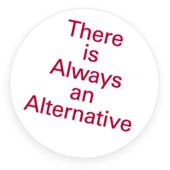There Is Always an Alternative
dal 27/5/2005 al 10/7/2005
Segnalato da
Dave Beech & Mark Hutchinson
Tim Brennan
Gareth James
Clive Sall
f.a.t.
Gillian Dyson
John Beagles
Deborah Holland
Dean Brannigan
Graham Ramsay
Lindsay Seers
Laura Emsley
Alison Marchant
Hayley Newman
Dan Mitchell
Giorgio Sadotti
Laurence Lane
Nick Crowe
Martin Vincent
David Mabb
Billy McCall
John Timberlake
Cornford and Cross
Brian Dawn Chalkley
Florian Zeyfang
Ward Shelley
Shaheen Merali
David Burrows
Adam Dant
Jeremy Deller
Chad McCail
Dave Beech
Mark Hutchinson
27/5/2005
There Is Always an Alternative
temporarycontemporary, London
Possibilities for art in the early nineties. The exhibition articulates an alternative history of art practice and a history of alternative art practices around the early 1990s based on a political understanding of the position of the artist. The title derives from an inversion of one of Margaret Thatcher's favourite ideological phrases, 'there is no alternative'.

Possibilities for art in the early nineties
Organised by Dave Beech & Mark Hutchinson
Dave Beech & Mark Hutchinson - Tim Brennan - Gareth James - Clive Sall / f.a.t. - Gillian Dyson - John Beagles - Deborah Holland - Dean Brannigan - Graham Ramsay - Lindsay Seers - Laura Emsley - Alison Marchant - Hayley Newman - Dan Mitchell - Giorgio Sadotti - Laurence Lane - Nick Crowe - Martin Vincent - David Mabb - Billy McCall - John Timberlake - Cornford and Cross - Brian Dawn Chalkley - Florian Zeyfang - Ward Shelley - Shaheen Merali - David Burrows - Adam Dant - Jeremy Deller - Chad McCail
There Is Always an Alternative articulates an alternative history of art practice and a history of alternative art practices around the early 1990s based on a political understanding of the position of the artist. The title derives from an inversion of one of Margaret Thatcher’s favourite ideological phrases, “there is no alternativeâ€. This is a phrase used by people attempting to undermine whatever alternative there is and in that sense is always false and falsifying. On the contrary, there is always an alternative. There Is Always an Alternative explores models and possibilities for artistic practice that resist, undermine or otherwise oppose the closures, absences and exclusions in dominant art discourse and practice. It puts forward an alternative history of British art in the early 1990s and in so doing, provide a resource for all those practices seeking to confront the limitations, both arbitrary and ideological, upon what can be done now.
The artists shown are committed to a theoretical and political understanding of art practice and, on the whole, to a form of collectivity: conceiving of their individual practices in relation to the practices of others. This was a time when the possibility of forging alternative co-ordinates for art practice seemed a practical as well as theoretical possibility. The constellation of practices gathered together in this exhibition, informed by political analysis as well as aesthetic theory, presented a different model of artistic practice than that which came to be seen as dominant in Britain and elsewhere in the 90s. As always, things could have been different and still could be different. One of the techniques available
to the status quo is to minimize or eliminate the sense of any alternative in the present or immediate future by obliterating the alternatives that existed in the past. The market is a very good mechanism for this sort of institutionalised selectivity. It is through recovering alternatives in the past, therefore, that we will inform and spur on alternatives in the future. There is Always an Alternative documents an under-represented array of radical practices from the early-90s in order to provide potential models of radical individual and collective art practice now and to come.
The project is curated around an overtly Marxist understanding of art and history, which is not to say that only committed Marxist artists will be shown and documented. Documenting a network of radical practices and expounding a theoretical understanding of radical art practice, There is Always an Alternative is focused around two exhibitions. The first exhibition at temporarycontemporary in London will be a survey of existing, or re-created, historical work. Artists will represent their own work and the work of those around them in the early 1990s. The second exhibition at The International 3 in Manchester, will act as a forum for current debates and ideas concerning radical, political and critical contemporary art. It will also be a response to the first exhibition. Documentation of the historical work in the first exhibition will act as a backdrop to this debate. Artists will participate in this second exhibition in direct response to these conditions of display. Focusing on collectivity and dialogue, the exhibition will change over its course.
This exhibition is kindly supported by Arts Council England.
Preview: Saturday 28th May, 6.30 pm – late
with performances by Tim Brennan & Dean Brannagan and Gillian Dyson
Artists’ Talks: Saturday 25th June, 2 - 6 pm
Catalogue available from the gallery: full colour; 96pp; writing by Dave Beech & Mark Hutchinson; John Timberlake; Jacqueline Cooke; Art & Language; John Roberts
temporarycontemporary, 2nd Fl Atlantic House, The Old Seager Distillery, Brookmill Rd, London SE8 4JT
Gallery open Sat-Sun 12-6 pm



